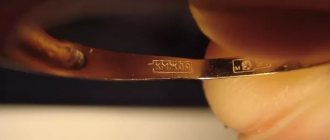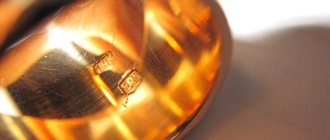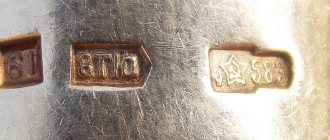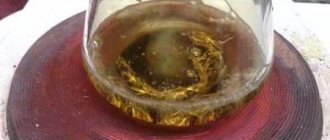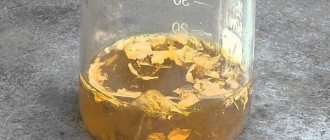Gold in water is not a myth, but a reality that does not require confirmation. Ions of element 79 of D.I. Mendeleev’s table are present in the human body, they are part of plants and, of course, water. The usual liquid is rich in noble metal, it transports gold, carries its particles along the bottom of the river, forming deposits. This water quality is what interests prospectors around the world, who enthusiastically explore rivers and streams.
Finding gold in water
Ion exchange resins - new hopes
Significant research on the extraction of gold from seawater was carried out after the development of technology for extracting gold from solutions using ion exchange resins. Such resins capture gold particles and accumulate them. Today, ion exchange resins are widely used in industry at gold recovery factories, where they are used to extract gold from cyanide solutions. After saturation with gold in special installations, the resin is purified from gold and can be reused, which reduces the cost of the process.
There are several other ways to extract gold using resins. One of them is that the bottoms of ocean ships are covered with resin. While the ship is sailing, the resin collects gold from the water. After some time, the resin from the bottom of the ship can be removed and gold can be extracted from it.
Another idea is to coat special floating catchers in the form of nets or panels with ion-exchange resin. The ship drags a catcher behind it, and when the resin is “saturated” with gold, the catcher is sent for cleaning.
Where and how to look for Au?
Gold is mined from water both in winter and summer. This element can be found using several methods, and cold weather will not stop an experienced prospector. First, you should study the algorithm of actions that will help you extract precious metal from water.
So, what should those who want to find Au do:
- Explore the area, choose a place, chat a little with the locals. Additional information will never be superfluous, for this reason it is worth carefully studying the area, looking at maps and collecting as much information as possible. Conversations with local residents will help establish where Au was found and how long ago it was.
- The gold content in water can be pleasantly surprising and even delightful, but you shouldn’t scuba dive underwater to find it. You can simply examine the rocks, study large stones, take a water sample.
- Using a tray, you need to take a sand sample or examine the bank of a river or stream for the presence of quartz pebbles. Quartz is the main satellite of gold, but you can search not only for it; pyrite and silver can “accompany” Au.
How to get gold and what devices can be used when mining precious metals:
- The water contains Au grains of sand, but they do not float with the flow, but crawl along the bottom. Over the years, grains of sand are compressed and can turn into nuggets and even deposits. A mini-dredge will help you find metal at the bottom. This is a device that works like a vacuum cleaner. The mini dredge sucks up sand and helps locate Au. The machine itself filters, washes and separates gold from impurities and dirt.
- A metal detector is another device that can help you detect precious metals in a river or stream. The device is immersed in water, it can react to gold and detect a deposit at a shallow depth. The coastal area is also being explored using a metal detector.
- Our ancestors used an Au tray when washing. Initially, the devices were made from sheep skins, but later the technology changed. Modern flumes are used for working on mountain rivers and fast-flowing streams. But progress does not stand still and, despite the fact that modern trays are lighter and more convenient, they are used mainly for taking water samples.
The presence of instruments will help speed up the search and increase the chances of success. But this does not mean that expensive equipment is a 100% guarantee of detecting a nugget in the ground or water.
Polymer sponge: a new method for extracting gold from water
An article published in the Journal of the American Chemical Society reported that scientists had found a new method for extracting gold from electronic scrap, waste water, sea water, and virtually anything. A special polymer structure was developed based on iron ions, 1,3,5-benzenetricarboxylate and poly-p-phenylenediamine. The polymer acts like a sponge, absorbing and retaining gold. The sponge is then destroyed and the precious metal is recovered.
Some researchers are enthusiastic and optimistic about this method. Its creators claim that every gram of polymer sponge can absorb 1 g of gold. At the same time, the technology allows you to extract up to 99% of the precious metal from a liquid in just 2 minutes.
Limited tests of the method in laboratory conditions have shown quite attractive results, but the moment when it will actually be possible to extract gold from seas and oceans is still a long way off.
Gold in the sand
Obtaining Au from coastal sand begins with taking it for testing: simply washing it in a tray, studying whether there are grains of the yellow metal.
You can dig up more sand, immerse it in bags and pour water into them. The fact is that sand is much lighter than gold. The noble metal will immediately settle to the bottom and can be seen, but the grains of sand will continue to float in the bag.
Diagram of the possible location of gold in a reservoir
You should filter the water with sand; if there is nothing at hand that can be used as a filter, then the liquid is simply drained. It will go away along with the sand, and Au will remain at the bottom of the bag.
Precious metal is mined from sand exclusively in the summer; in winter, prospectors simply search the coastal zone, examine the stones, but do not wash the sand.
Most often, sand is simply taken for testing, it is lifted from the bottom of the river or dug near the shore. The sample helps determine whether there is Au in the selected location and how much of it there is in that location. If you manage to find more than one or two grains of gold, then you can continue your search. If the amount of yellow metal is negligible, the searchers go to another place.
At what depth can a nugget be found?
- Gold weighing no more than one gram is most often found under a layer of sand of 10–13 cm, and it is not so difficult to get it.
- If you lift the soil 15–30 cm, there is a chance to find a nugget weighing more than 1.5 grams.
- If you dig down to the soil that comes immediately after the sand, you can find a whole piece of noble metal weighing more than 100 grams.
However, Au mining is associated with certain difficulties and there are no guarantees that the “excavations” will end in success. For this reason, it is recommended to study the area and take samples of soil, sand and water before starting the search.
Gold-extracting bacteria
An interesting idea for extracting gold from sea water was proposed by scientists from the University of Heidelberg and the German Cancer Research Center. They believe that special bacteria Delftia acidovorans will help precipitate the precious metal from the liquid. These microorganisms are found only near gold deposits, are adapted to the environment and are able to absorb metal from solutions even with low concentrations. The researchers isolated the necessary genes and introduced them into more common bacteria such as E. coli. A patent application has already been filed.
GPS
In terms of scale, the GPS deposit with resources of 12–15 million tons of ore mass, according to accepted gradations, can be classified as large;
in terms of copper content - very rich; according to the degree of oxidation - mixed; according to the number of associated elements - to complex ones [1]. Thus, based on the above material (Table 1), we believe that the development of the extraction of sulfide ores from GPS deposits in its licensed areas in the central part of the Atlantic Ocean will be of great geopolitical and innovative importance for the Russian Federation (Tables 1 and 5 ). As an analogue, we adopted the project of the Canadian company Nautilus Minerals. As can be seen from the table, the production of polymetals from GPS corresponds to a fairly large-scale mine.
| MSR | Production | |
| 2040 (30) | 2060 (50) | |
| Cu, thousand tons | 150 | 300 |
| Zn, thousand tons | 5 | 100 |
| Au, t | 20 | 24 |
| Ag, t | 90 | 200 |
Table
5. Forecast of production and consumption of metals from GPS in Russian licensed areas
What to expect in the future
The economics of gold extraction depend primarily on its content in seawater. So far, the data on this issue are mixed. The neutron activation method for analyzing the composition of liquids, developed and mastered in recent decades, has made it possible to conduct interesting research. Employees of the research vessel "Mikhail Lomonosov" conducted research in exactly this way.
In the tropical Atlantic Ocean, they analyzed 89 seawater samples for gold, taken at different points and at different depths, even from a depth of more than five kilometers. According to research, the average concentration of precious metal in seawater is significantly higher than previously established. Some samples contained almost a thousand times more gold than could be expected. This confirms the previously stated assumption that the gold content varies very significantly in different places and at different depths.
How to pan or mine gold using a dredge
Before using a dredge for gold mining on rivers, a company or enterprise must collect a whole package of documentation and take care of obtaining the appropriate license. In this case, management must comply with a number of requirements:
- first of all - to conduct geological exploration;
- perform an analysis of the quality of the material, perform detailed calculations;
- prepare detailed designs for the development of future fields;
- take care of obtaining an allotment (land and/or mining).
If we are talking about using, for example, a mini-dredge on a private basis, it should be remembered that such activity is illegal and is prosecuted in accordance with the current regulatory framework.
True, this is not an obstacle for many of our compatriots - such a complex, full of adventurism, but, nevertheless, very profitable in some cases, the fishery enjoys considerable popularity in some regions of our state.
How to mine gold sand by dredging
The process of washing sand with a dredge:
- The soil, which potentially contains particles of precious metal, is placed in the receiving hole.
- The installation washes the soil, removing excess fractions from it. The latest models of profile equipment are equipped with an automatic flushing function for coarse rock, which eliminates the risk of damage to the device.
- The washed soil is fed into a drum, where it is wetted and crushed into smaller parts.
- The next stage is that the soil is sent to the enrichment sluice, and then the remaining raw materials, which are guaranteed to contain nothing valuable, are thrown back.
The functionality of the dredge for sand extraction provides the ability to make individual settings, in particular:
- intensity of rock cleaning;
- fuel consumption;
- drum rotation speed;
- cleaning method (depending on soil type).
How to wash by hand
To wash goldfish with your own hands using an ordinary tray, you need a round or rectangular trough up to 40 centimeters in size and a sieve. If, after washing, at least one grain remains in the sieve, the miner can be congratulated: the placer has been found. If not, you need to try further. Of course, such washing requires enormous patience.
The principle of operation of the mini-dredge is the suction of sand and small particles of pebbles from the bottom with mechanical separation of gold from the rock. The disadvantage of using this device is that it creates a lot of noise, attracting the attention of conservationists. To mine precious metals in this way, I strongly advise you to first purchase a license, otherwise you will face problems with the law.
TOP 10 Russian rivers rich in gold reserves
Prospectors with experience have compiled a truly golden top ten watercourses, where the treasure of the same name is most abundant - that’s where it’s worth looking for:
- basin of the Siberian Lena River;
- river length Bom;
- Jalon Creek;
- Millionny stream;
- Unakha River (all in the Amur region);
- the Bodaibo River in the Irkutsk region (the city of the same name with gold mines is even mentioned in Vysotsky’s “thieves’ lyrics”);
- Bolshoy Chanchik River, a tributary of Bodaibo;
- Alekseevsky stream in the Kamchatka region;
- the Talga River in the Khabarovsk Territory;
- the Sanarka River is the only one not in Siberia or the Far East, but in the Urals, in the Chelyabinsk region.
There are quite a lot of large grains on Bodaibo and in the Millionny stream; nuggets can still be found in other streams.
Heavy metals in water
Natural fresh waters are polluted with heavy metal ions due to anthropogenic human activities. The danger of water pollution with heavy metals lies in the lack of an effective self-purification mechanism. Impurities migrate from one water storage facility to another, settling along the way in the organisms of representatives of aquatic fauna and depositing in plant tissues.
The main sources of water pollution with heavy metals are industrial enterprises, or rather, insufficiently treated wastewater and slag dumps. Harmful substances enter the soil along with sediments filtered through slag. In the case of injection of industrial waste water into mines and pits, there is a significant impact on the quality of groundwater.
Let us remind you that experts do not recommend drilling wells to create a source of drinking water supply in the immediate vicinity of industrial enterprises. Heavy metals dissolved in water migrate with groundwater and end up in aquifers used as water supplies and in surface water bodies.
What happens next to the mined gold?
The mined metal still contains impurities. They are removed using refining. At the initial stage, the raw material is cleared of iron impurities and treated with nitric acid, while gold precipitates. Further processing is carried out using hydrochloric and nitric acids and evaporation. This method allows you to achieve a purity of the substance at the level of 99.95%.
To achieve maximum metal purity, electrochemical refining is used: hydrochloric acid in solution serves as an electrolyte, the anode is the raw material for purification, and the cathode is a gold rod of the highest standard.
Gold producing countries
Gold is not mined in all countries. This is due to the rarity of this element in nature, as well as the complexity of industrial extraction technologies. There are few open deposits in Russia, mostly closed mines, and our country is a leader in them (4th place).
Previously, the most gold-producing countries were the USA and Canada, then China became the vanguard (it produces about 13% of the world's reserves). The list of the main gold-mining countries is as follows - China, Australia, South Africa, USA, Russia, Peru, Uzbekistan.


